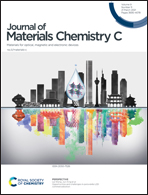Novel tri-[2]rotaxane-based stimuli-responsive fluorescent nanoparticles and their guest controlled reversible morphological transformation properties†
Abstract
Developing novel stimuli-responsive fluorescent nanomaterials and achieving controllable regulation of the morphology and optical properties of this kind of material is very important. Herein, we demonstrate a novel way to construct stimuli-responsive fluorescent nanomaterials by rotaxanes. Significantly, a feasible method to reversibly control the morphology of nanomaterials from nanoparticles to nano-film has been developed. At the beginning of the work, a novel pillar[5]arene-based tri-[2]rotaxane was designed and synthesized. The tri-[2]rotaxane shows selective fluorescence response to suberic acid. Moreover, the tri-[2]rotaxane could self-assemble into fluorescent nanoparticles. By alternating addition of suberic acid and trimethylamine, the tri-[2]rotaxane-based nanomaterials could reversibly change from nanoparticles to nano-film, meanwhile, the fluorescence of the tri-[2]rotaxane shows “off–on–off” switch; this process is controlled by the formation and destruction of intermolecular hydrogen bonds. Reversible control of the morphology and optical properties of rotaxane-based nanomaterials have broad prospects in biomedicine and smart materials.
![Graphical abstract: Novel tri-[2]rotaxane-based stimuli-responsive fluorescent nanoparticles and their guest controlled reversible morphological transformation properties](/en/Image/Get?imageInfo.ImageType=GA&imageInfo.ImageIdentifier.ManuscriptID=D0TC05922F&imageInfo.ImageIdentifier.Year=2021)


 Please wait while we load your content...
Please wait while we load your content...